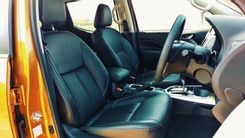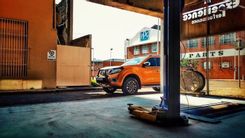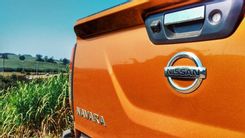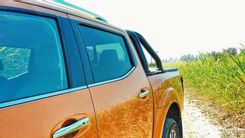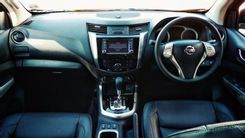THIS ROUGH-AND-TUMBLE PICKUP NOW HAS A SOFTER SIDE
Nissan has been a mainstay of the South African pickup market for as long as most people can remember. But recently, the choice for Saffas has usually come down to the Ford Ranger or Toyota Hilux, with the Navara losing out to these two.
And with 80 years of experience in the pickup segment, Nissan went back to the drawing board with the latest Navara to create a new model that they hope has the merits to stand up to a hugely improved opposition – and Nissan came back with the new Navara Double Cab.
Not only is the new Navara as tough and rugged as ever, it’s also a stylish, competent and well-equipped vehicle that will surely meet the diverse requirements of many premium double cab owners. It’s now even more capable of being a family’s only vehicle.
This new Navara is far beefier than the previous generation; the front bumper is a lot deeper, the bonnet is more heavily styled, with bulges said to emulate the lines of a man's muscular arms; as well as wider arches giving it an aggressive stance. It’s also said to be some 70kgs lighter than its predecessor, but now boasting improved aerodynamics.
It's exterior is well-dressed with a black alloy sports bar, satin alloy roof racks and side steps, LED projector headlights, heated power door mirrors, heaps of chrome highlights and a slide-adjustable load securing system in the cargo bed, to name a few. The distinctive styling feature is the strong v-shape in the grille that flows through into the bonnet. The v-motif gets another run in the tailgate with a bold Nissan badge; the pickup definitely has plenty of presence.
Borrowing internal styling cues from the Pathfinder and X-Trail stablemates, there is no doubting the Navara is a hefty step forward in the comfort stakes. The Navara LE comes well equipped with numerous luxury appointments including heated and leather-accented front seats with an eight-way power adjustable driver's seat, leather accented handbrake and tilt-adjustable steering wheel, dual-zone climate and multi-media dashboard interface including smartphone and Bluetooth connectivity, six-speaker sound system and lots more.
The steering wheel looks far more like that of a passenger car, while cupholders have been cleverly placed next to the air-con vents to keep your drink nice and cool. Material quality has improved, though there’s still plenty of hard plastic around the place. A 7-inch integrated colour display with touch screen and navigation dominates the cabin. In front of the gear shifter is a handy space to store a phone or music player, close to the USB and auxiliary plug.
There is plenty of space inside the Navara, with heaps of room up front and adequate legroom for rear passengers. The seatback is still fairly upright (as is the way with most dual cabs), but with enough width for three passengers, the double cab will take five people and their kit with no problems. There’s a nifty sliding glass window in the rear windscreen. Operated by a switch on the dashboard, it facilitates access to the bin (especially if a canopy is fitted). With no canopy in place, opening this little window improves in-cab ventilation. However, with it in the open position, the rear window privacy tinting is effectively doubled and this can affect rear visibility through the double glass section at night.
The Navara’s safety is 5 star. Incidentally, that’s how many stars it scored in the NCAP crash testing. Passive safety features include driver and front passenger front and side airbags, driver's knee airbag and side-curtain airbags front and rear, while active safety includes numerous electronic stability controls including brake force distribution. There's also LED daytime running lights, a reversing camera, reversing sensors, and more.
South African Navara’s are only available with a single motor choice - a smooth and powerful (YS23DDTT) 2.3-litre DOHC four cylinder twin-turbo diesel. Its 200MPa injector system, thermal management system, electrical variable displacement oil pump and two-stage inline turbochargers provide a steady stream of power and torque throughout the rev range, with a small primary unit providing good throttle response at low rpm and a larger secondary taking charge at higher rpm. With 140kw at 3,750rpm and a hearty 450nm serving of torque from 1,500-2,500rpm, it's an efficient match for the Navara’s 2-ton kerb weight. Make no mistake about it; it is an all-round impressive piece of kit.
With 140kw, it’s enough to get it from 0-100kph in a fraction over ten seconds. That makes it more powerful than the 2.0 BiTDi Amarok, 2.8GD Hilux and 2.4Di-D Triton, and marginally behind the 3.2-litre Ranger and BT-50 siblings. It also has a gargantuan 80 litre fuel tank; it can tow 3,500kgs and has a payload rating in excess of a tonne. The Navara rides on a 3150mm wheelbase which is 70mm shorter than Ford's Ranger, but 65mm longer than Toyota's Hilux. Its off-road credentials include a competitive 228mm of ground clearance, an excellent lateral tilt angle of up to 50 degrees, 32.4 degrees approach angle, 26.7 degrees departure and 23.8 degrees ramp-over angle, with a wading depth of up to 700mm.
Driving the Navara is no hardship, although you never forget that it’s been designed to withstand workaday mistreatment and hard use. While there is some noticeable diesel clatter at start-up and things can get noisy under hard power, the Navara is relatively quiet and refined for a pickup. The oil-burner proved burly and robust when called into action. Get it working above 1,300rpm and the linear power delivery is smooth. The gearbox does like to hang onto the ratios for a bit longer than is necessary, exacerbating the noise from the engine, but some early shifting via manual control can help here. Acceleration is brisk and braking is good but the steering has an overly heavy or ‘dead weight' feel to it that remains linear regardless of road speed. On the subject of braking, this is via front discs and rear drums inside 18-inch alloy wheels with 255/60R18 tyres and a full-size alloy spare.
When Nissan launched its all-new Navara range, it certainly raised eyebrows with its bold decision to equip its dual cabs with coil-spring rear suspension. Nissan argued that coil springs provide superior ride quality to leaf springs particularly when unladen, which is the majority of time for most pickup owners. This was a notable departure from the long accepted wisdom of leaf springs, which since the horse-and-cart days have been the preferred method for suspending heavy payloads. You see the thing with pickups is that in their unladen state the rear leaf springs are completely stiff. So the front travels car-like over a bump, the rear axle hits it and starts to skip and bounce. This completely disappears once you have weight in the flat bed, but for the majority of driving situations the rear will most likely be empty. Some will prefer leaf springs for their simplicity and durability, but there is no question that the Navara suspension delivers better handling, better ride comfort and more off-road capability. On the road, it settles into corners quite nicely and resists being bounced off-line by mid-corner bumps.
Pickups have come a long way since Ford banged out the first model back in the 1930s. Double cabs have become particularly popular as weekday worker and weekend family haulers, and for this reason Nissan adopted this somewhat revolutionary approach when designing the new Navara.
Nissan are trying to bring the Navara more into line with the high end, crossover segment. Rather than being a utilitarian workhorse, you could opt for one of these instead of say an X-Trail, and this too is reflective in pricing which isn’t night and day relative to the X-Trail.
The Navara starts at:
R528 500 for the 4X4 SE.
R591 500 for the 4X4 LE.
R611 500 for the range-topping 4X4 LE Automatic.


